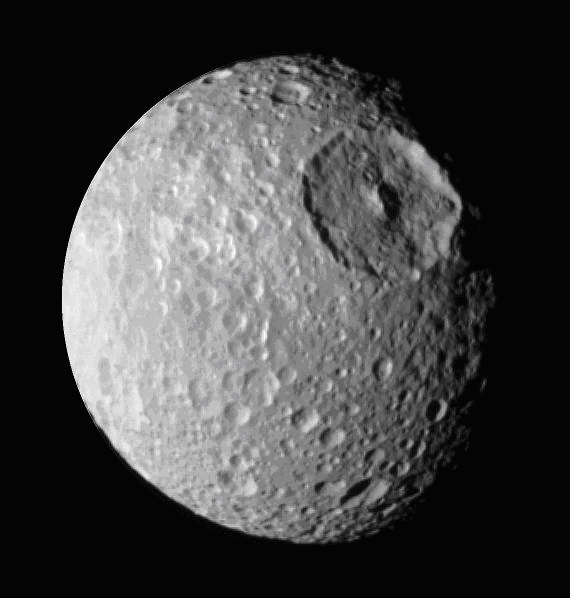
home •
about •
essential guide •
picture of the day •
thunderblogs •
news •
multimedia •
predictions •
products •
get involved •
contact
picture of the day archive subject index
Saturn’s stricken moon Mimas. Credit: NASA/JPL/Space Science Institute
Jun 25, 2008
Mal de MimasWhat could blast a crater 130 kilometers wide without destroying this moon? The answer might be electricity.
Saturn’s moon, Mimas is another of those “mysterious” objects that inhabit the solar system. Its appearance reminds one of the fanciful “death star” from a popular movie several years ago. The single giant crater that dominates one hemisphere is unique in that it is one-eighth the diameter of the moon itself. If a similar-sized crater were formed on Earth it would cover almost half of the Pacific basin.
In our previous article about Tethys, a sister moon to Mimas, the disproportionately large features – craters, deep canyons and kilometer-high cliffs – reflect violent activity that could have destroyed the 1000 kilometer-wide moon. Why such enormous shocks do not disrupt the material bodies on which they have been discovered is another mystery that baffles planetary scientists.
Very much like the Odysseus Multi-Ring Structure on Tethys is Herschel crater. Named after Sir William Herschel, who discovered Mimas in 1789, the hexagonal astroblem is 130 kilometers wide with a towering central peak. Such craters are theorized to form when asteroids impact the surface and explode, blasting the material into space.
One standard explanation for why so little debris remains behind is that the moons, like Mimas, have little gravitational attraction so the remnants of the explosive events aren’t retained in the vicinity. It sounds like a reasonable hypothesis until one examines the craters on large planets like Earth and Mars. Many hundred-kilometer-wide “impact sites” on Earth also demonstrate little eruptive fallback – their flat-bottomed floors and steep sidewalls are swept clean, although glassified breccias are often incorporated into the rims and walls.
To NASA mission specialists the most labyrinthine puzzle of all, however, is the shape of Herschel crater: it is a hexagon. How can the detonation of a colliding rock cause a hexagonal crater? No experiment has been able to demonstrate a polygonal shape left behind after an explosive event. Explosions do not aggregate constituent particles into stable configurations; they induce chaotic behavior that leaves little in the way of identifiable forms.
The answer to how immense craters with similar morphology can develop with straight-sided hexagons is found in plasma discharge experiments. For example, Wal Thornhill explained the enigmatic hexagonal cloud feature on both Jupiter’s and Saturn’s north pole by referring to vortex instabilities seen in the lab during electron beam experiments. See “2008—Year of the Electric Universe.” He writes, “Given the almost unlimited scalability of plasma phenomena, it is not surprising that there are galaxies exhibiting hexagonal structure within a circular arc (NGC 7421, NGC4676A) and diocotron instabilities in their spiral arms (NGC 3646). (The arcs are formed electrically not by collision). In addition there are circular and hexagonal structures within the spiral arms (the Hodge object in NGC 6946).”
In previous Picture of the Day articles, we have attempted to provide evidence for plasma discharges on planets and moons. Lightning bolts, diffuse glow-mode clouds of energetic particles and rotating Birkeland currents are suggested as causative agents for the bizarre conditions on celestial bodies, like Mimas. It appears as if Mimas might have been caught in the grip of a titanic particle beam that excavated Herschel crater and the other geological features incised on its face. Due to the plasma instabilities in the discharge, a hexagon was cut deeply into its crust. When the electrical energy was withdrawn, Herschel crater remained – a “fossilized” geometric shape permanently burned in.
By Stephen Smith
__________________________________________________________________________Please visit our new "Thunderblog" page
Through the initiative of managing editor Dave Smith, we’ve begun the launch of a new
page called Thunderblog. Timely presentations of fact and opinion, with emphasis on
new discoveries and the explanatory power of the Electric Universe."The Electric Sky and The Electric Universe available now!

|
|

|
EXECUTIVE EDITORS:
David Talbott, Wallace Thornhill
MANAGING EDITORS:
Steve Smith, Mel Acheson
CONTRIBUTING EDITORS: Michael Armstrong, Dwardu Cardona,
Ev Cochrane,
C.J. Ransom, Don Scott, Rens van der Sluijs, Ian Tresman
WEBMASTER: Brian Talbott
Copyright 2008: thunderbolts.info
![]()
home •
thunderblogs •
forum •
picture of the day •
resources •
team •
updates •
contact us

